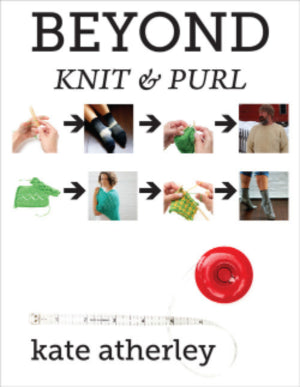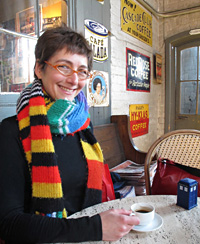Through Twitter, a knitter asked about the number of gusset stitches:
How many should there be, how to pick them up, and how does this affect fit?If you want to be scientific about it, it goes like this... figure out what circumference you need around the arch of your foot. Take the measurement, subtract off about 10-15% and then multiply that by your stitch gauge.
Let's use my numbers as an example. My foot is 8 inches around the ball of the foot, but 9 1/2 inches around the arch. At 8 stitches an inch, I calculated the following stitch count for my sock: 8 inches - 10% is about 7 inches, and 7 x 8 = 56.
For my gusset circumference, 9 1/2 inches less about 10% is 8 1/2 inches. 8.5 x 8 = 68 stitches.
Let's consider a top-down flapped heel first. Your instep is usually half the total number of stitches - for me, that's 28. Check the pattern to see how many stitches are leftover from the heel turn - for my favourite band heel turn, I have 12 left over. So I've got 40 stitches after the heel turn. And I need to make up the remaining 28 stitches with the gusset pickup - that's 14 each side. (And when I'm working a top down sock on 56 stitches, I aim to pick up 14 or 15, so that's just about right!)
Now: for many sock patterns, the instructions are simply to pick up one stitch for every slipped stitch on the side of the heel flap - that is, one stitch for every two rows. I submit to you that that number is too few. No matter how many rows you work. I like to pick up one stitch for every slipped slipped stitch at the side of the heel flap, plus two more. Yes, really. Two.
Aha, you say! But if I pick up more stitches, I'm going to get holes. Nope! Done properly, picking up extra stitches actually eliminates the risk of holes.
Avoid that tempting strand that runs between the stitches. If you pick up there, you're absolutely 100% going to create a huge hole. It's going to be loose, as that strand tends to stretch out when you're working the heel flap. And if you pick that up, you're effectively creating a yarnover - think about it, you're picking up a strand between the stitches. And even if you're "clever" about it, and work that yarnover through the back loop to twist it, you're still going to get a gap as you're still working an increase, and therefore forcing apart the instep and the heel stitches, creating a bit of a separation. The trick is to pick up those two extra stitches in the straight line, continuing up from the slipped stitches. You're very deliberately picking up a stitch or two above the separation point between heel flap and instep - this hides that stretched-out strand of yarn in the break between the flap and the instep. To pick up the last couple, you're no longer putting the needle under the edge stitch, but poking it through from the RS of the fabric to the inside of the sock. (BTW, you are putting the needle under both strands of the edge stitch to do the pickup, aren't you? You should be.) (More on this in this blog post.)
For a toe-up heel, if I'm working on 56, I need to work gusset increases until I get to 68 stitches - the different is 12, so that's 6 on each side. That having been said, for most toe-up flap-and-gusset constructions, the number of rows in the heel flap is set by the number of gusset stitches, so I tend to consider this as a minimum number of gusset stitches. A 12-row heel flap sits too low on the heel for my liking, so I usually use the following formula: gusset stitches per side should be about 20% of the total sock stitches, so for a 56-stitch sock, I'd do 11 or 12 gusset stitches per side. Some knitters use 25% as their usual number, but I personally find this too many - I get bagginess around the front of the heel.
And Jenn asked in a comment:
Any hints on compensating for high insteps?There's a few possible elements at play here. First of all, I'd always recommend a sock with a flap and gusset construction, as that allows you to add extra circumference around the arch/instep. If working top-down, work an extra long heel flap, and then pick up "enough" gusset stitches - as above. As to how long the heel flap should be, measure the vertical distance from the top of your instep to the ground. Aim for that length.
My widest point comes when putting the sock on - getting it over my heel/instep. If I knit the 'right' width for my calf I need to stretch the sock to the point I'm afraid of snapping something to get it over my heel. I've played with a few things (different heel flaps/stitch counts etc) but it seems if I want to actually get them on, they are baggy on the legs
For toe-up, you'll need to reverse engineer this a bit. Measure that length, and then calculate how many rows that is. (Flap length x round gauge in inches.) If you're working a "typical" toe-up sock where the heel flap is created by decreasing away a gusset stitch every row, your total number of gusset stitches - both sides added together - needs to be the number of rows you need. So at 10 rows/rounds an inch. if you need a 3 inch heel flap, that's 30 rows. And so you need 15 gusset stitches per side.
I hope that helps my readers! Anything else?







3 comments:
Fabulous Sock Fit commentaries. You have addressed so many of the issues that crop up numerous times.
Thank you so much for generously chatting with us.
Karen
Your post today comes at the perfect time. I was just thinking I need to rework the sock I'm knitting - frog back the heel and increase the heel flap. I need more stitches for the foot. The recipient of the socks as a narrow ankle and a wide flat foot.
I am not sure now just how often I have knitted the Basic Ribbed Sock since the first one two years ago - I have just completed another pair - I was terrified to start knitting socks again after at least a 30 year break and this pattern has me hooked. They fit, the pattern doesn't get boring and I am loving reading the technical stuff too! I know I need to try another pattern - but so far other patterns don't work as well. So at the moment whenever I am in between bigger projects I knit another pair - for me and for my sister as we are both dog walkers and like nice socks. Thank you so much.
Post a Comment